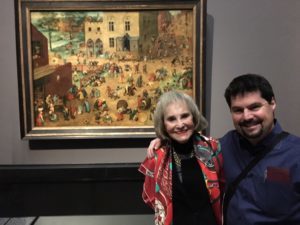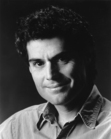Michael Shapiro's Blog, page 5
March 27, 2019
Boys of Winter: Playing baseball with my heroes at SF Giants fantasy camp, Lexus magazine
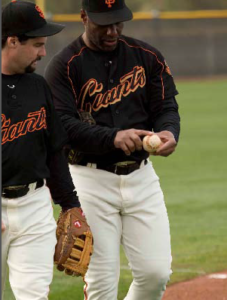
At SF Giants fantasy camp in January, 2008, with former player Mike Felder.
Back in 2008, I received a dream assignment from a gorgeously designed magazine called Lexus that’s read by more than 1 million Lexus drivers in North America. The editor asked if I’d spend a week in January playing baseball at San Francisco Giants fantasy camp. It took me a millisecond to agree. I went to Scottsdale, Arizona, where the real Giants hold their spring training, and played on fields with childhood heroes Vida Blue and Jeffrey Leonard. Our manager was longtime Giants first baseman J.T. Snow.
Snow was friendly the first few days but when the magazine’s photographer arrived and he learned I was a journalist, he cooled toward me. He didn’t like the media during his playing days and even at fantasy camp his disdain for scribes remained – he barely talked to me the rest of the way. But the other players were great: Former shortstop Rich Aurilia made an appearance and was happy to talk with anyone and everyone – his knowledge of the game is tremendous. Former players who weren’t always beloved by fans, such as Atlee Hammaker and Johnny Lemaster, were true stand-up guys. And utility man, Mike Felder, our co-manager, was a brilliant instructor.
I wanted to call the story “Boys of Winter” as camp is held in January but my editor went with “Boys of Summer”- I’ve adjusted the title here.
Click to read the full story: Giants-fantasy-camp
February 1, 2019
Once in a Lifetime: Visiting Bruegel in Vienna with my mom, Perceptive Travel, Feb. 2019
In November 2018, my mom saw a story in Art News about the first true Pieter Bruegel the Elder exhibtion ever, to be held at the Kunsthistoriches art museum in Vienna. She asked if I wanted to make a trip to Austria and I said I’d love to but had a book deadline approaching. We’d shared a love of Bruegel’s art since I was about 10 years old when she brought home a puzzle of Bruegel’s “Children’s Games” that we put together over the course of a few weeks. The more I thought about it the more I felt we should try to see this. My mom was undeterred by the fact that we’d have to go in winter as the exhibition closed Jan 13, 2019.
We got there for the final week – here’s the story that ran in the February 2019 issue of Perceptive Travel magazine:
https://www.perceptivetravel.com/issu...
January 10, 2019
A Farming Renaissance in Puerto Rico, Inspirato magazine, Winter 2019
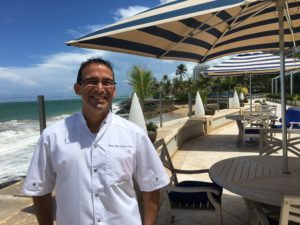
Chef Juan Jose Cuevas outside his restaurant, 1919, at the Hotel Condado Vanderbilt in San Juan, Puerto Rico
Last September, a year after Hurricane Maria devastated the U.S. territory of Puerto Rico, I was sent to the island to report a story about how some farmers were shifting from export crops to growing food for local people. I met some savvy, organic, badass farmers, such as Daniella Rodríguez Besosa, who are eager to grow food for people rather than profit. And I met chefs such as Juan Jose Cuevas who oversees San Juan’s 1919, one of the island’s top restaurants, who are working with these farmers to help them survive. It’s the type of story that involves so much of what I love to cover: sustainability, commitment to place and collaboration. I even shot all but one of the photos for the story. Thanks to Dina Mishev for the assignment.
Here’s the story from Inspirato magazine:
July 1, 2018
Interview: Oceanographer Sylvia Earle, The Sun, July 2018
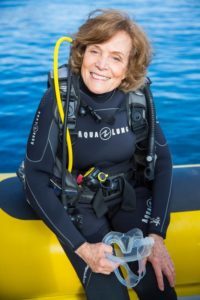
Dr. Sylvia Earle on a dive.
Dr. Sylvia Earle has been one of my heroes since I saw the 2014 documentary “Mission Blue” about her tireless work on behalf of the oceans that sustain us. I had the privilege of interviewing her for my Saturday Evening Post story, “Oceans on the Edge” – we spoke for nearly three hours and I had far more material than I could fit in the Post story. So I sent the transcript to The Sun, one of the few print magazines that publishes long-form interviews. I’d interviewed Studs Terkel and Barry Lopez for The Sun years ago and I’m thrilled to be back in their pages.
Click here for the interview which is prefaced by a short biography about her life and work.
April 15, 2018
Man stricken with ALS finds new voice in singing partner; June 12, 2018
Sometimes a story comes along that breaks your heart before you start interviewing. And then when you get to know the subjects it becomes even more wrenching yet at the same time uplifting. The story of aspiring musician Bernie Dalton, who refused to let the loss of his voice shatter his dream, reveals the resilience of the human spirit.
To watch their video of “Unusual Boy,” made for NPR’s Tiny Desk contest, click here.
To read my story for The Press Democrat, click the link above or read the text below.
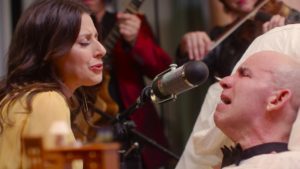
Bernie Dalton and his “voice” Essence Goldman recording a video for a National Public Radio contest.
By MICHAEL SHAPIRO
FOR THE PRESS DEMOCRAT
When Bernie Dalton – a surfer, single father, pool cleaner and aspiring singer – lost his voice, neither he nor his voice coach were initially alarmed.
And when it didn’t come back, he wouldn’t let that stop him from making the album he’d always dreamed of creating.
A few months earlier, just after turning 46, Dalton had responded to a Craigslist ad and begun taking voice and songwriting lessons from San Francisco musician Essence Goldman.
“He’d always show up early with a big smile on his face, very eager, waiting for me,” Goldman said in a phone interview from her home in San Francisco’s Richmond district.
When Dalton came to her in January 2016, they didn’t start by talking songcraft – they discussed their lives.
“I feel that voice is the direct channel to somebody’s spirit, so I tried to help him feel comfortable,” Goldman said. Songwriting is about “honesty and sharing your truth. So we cut right to it.”
Dalton, who lived in Woodside, talked about being a single dad, while Goldman shared that she’d recently been through a separation and was a single mom.
“He was extremely encouraging and supportive,” she said. “A very sweet (platonic) relationship was born.”
As a songwriter, Dalton was an “absolute beginner” but showed “a lot of natural talent,” Goldman said.
Once he brought her a fully formed original song – another day he sang the blues classic, “I’m Tore Down” by Freddie King, which Goldman recorded on her iPhone.
“That is the only known recording of Bernie singing in the world because shortly thereafter his voice disappeared,” she said.
Dalton thought the cause might be overexposure to chlorine from cleaning pools, and he sought natural healers.
Though he couldn’t sing, Dalton kept coming to see Goldman for lessons, bringing her lyrics and working on his songs.
Sometimes he’d come up with his daughter, Nicole, and she’d sing.
When weeks without a voice became months, Goldman became extremely concerned.
One day he came to a lesson and began drooling on a guitar.
“Bernie, you’ve got to see a neurologist,” Goldman told him. “This is really bad. You can’t wait.”
Dalton finally got some medical tests during the spring of 2017 – a year after he’d lost his voice.
“I think that there was optimism – you could call it denial – but Bernie is an extremely optimistic person almost to a fault,” Goldman said. “He just kept thinking he was going to get better.”
It’s didn’t take long to diagnose his condition, the disease Dalton and Goldman most feared: amyotrophic lateral sclerosis (ALS), also known as Lou Gehrig’s disease.
Those afflicted with ALS, such as 49ers star receiver Dwight Clark who died June 4, suffer from degeneration of nerves in the brain and spinal cord, which cause partial and then complete paralysis.
Most victims die within a couple of years.
Despite the shock and his deteriorating physical condition, Dalton could still drive and kept coming to San Francisco for lessons with Goldman.
He asked for advice about how to tell his teenage daughter, which was “gut-wrenching,” Goldman said.
“I urged him not to wait. I told him she would want to know so she could be there to help him and comfort him.
“He didn’t want to burden her. It was finals time at her high school, late spring 2017. He wanted to wait until finals were over, and that is what he did,” Goldman said.
“He is always thinking about other people before himself. Bernie is the most selfless person I’ve ever met.”
Goldman had lost her father to pancreatic cancer and said she saw herself and her dad in Dalton’s relationship to Nicole.
“When Bernie was diagnosed with ALS, it was like losing my dad all over again,” she said.
Goldman stopped accepting money for the lessons and offered to start a fundraiser so Dalton could travel with his daughter before his symptoms worsened.
But he didn’t want to take a trip – he wanted to make an album.
She asked him: “Bernie, how are you going to make an album if you can’t speak or sing?”
He replied: “I want you to be my voice,” but initially she didn’t think she could do that.
Dalton kept sending Goldman handwritten lyrics, asking her to help him put music and melody to his words.
“I was working on my own album,” she said, a follow-up to her 2016 release, “Black Wings.”
“But he’s persistent, extremely persistent, and he kept sending me the lyrics in the mail. He said, ‘This can be your next record.’ And there was just something so important and heartfelt about what he was doing.”
Goldman launched a GoFundMe campaign that raised more than $23,000 to pay for producing Dalton’s album.
Members of Goldman’s band joined Goldman and Dalton in a recording studio and knocked out a song a day.
Dalton was involved in every aspect of song creation, from the melodies to the horn parts, offering his comments on a dry-erase board or giving a thumbs-up or thumbs-down to the musicians’ suggestions.
They named the band Bernie and the Believers and titled the album, “Connection.” Last February they had an album release party at the San Francisco club Slim’s.
The first song Dalton wrote, “Simon’s Hero,” is a message to his daughter’s future children, kids that Dalton will probably not live long enough to know.
Dalton and Goldman crafted that song, whose title references Dalton’s hero Paul Simon, in her living room as she played a Dobro guitar.
“I wrote the music and melody in about 15 minutes, … the song was there,” she said.
“I second-guessed myself when I wrote it. Like, I’ve never written anything like this. This doesn’t feel like me, but it wasn’t supposed to feel like me. It wasn’t my song. I channeled him.”
Last March, the band released a video, a submission to NPR’s Tiny Desk Concert contest, in which Dalton listens to Goldman sing the Bernie and the Believers song, “Unusual Boy.”
Dalton is at the Cupertino Health & Wellness Center, wearing a hospital gown, a bowtie around his bare neck.
He opens the video with a Stephen Hawking-like automated voice saying: “My name is Bernie Dalton. My lifelong dream was to record an album … I could no longer speak or sing, so I asked my singing teacher, Essence, to become my voice.”
Goldman then appears in a yellow dress, backed by her band, and sits next to Dalton on his hospital bed. She proceeds to sing her heart out.
Soon Dalton’s jaw begins to tremble, tears form at the outer edges of his eyes and trickle down his cheeks.
Goldman kept her composure and continued to sing.
“I just sang the song to Bernie. I became the song in that moment,” she said during the phone interview in early June.
“It was as pure a communication as I’ve ever experienced. I lost myself in the song. I had to stay strong and be the rock because that was what was needed.”
She said music “is like a meditation. I just completely focused on the music and beamed him all the love in my heart through the song.”
What’s clear is the deep love that Goldman and Dalton share, not a romantic love but perhaps a more pure connection.
“He is my spirit brother, my soulmate. There is a mysterious force at work here, and it’s bigger than all of us,” she said.
“Bernie is a really special person, and I’m honored that he asked me to be his voice. It’s been the honor of a lifetime.”
To become Bernie’s voice, Goldman had to transform herself from a vocalist to an instrument, but it’s a journey she’s found immensely gratifying.
“As a songwriter, our greatest work is to be of service and to communicate something meaningful,” she said.
“The role of music is to create magic and to move people to speak truth. I can’t think of any experience I’ve had musically that’s had more magic and truth than this.”
—
Michael Shapiro writes about entertainment and travel for national magazines. Contact: www.michaelshapiro.net.
April 9, 2018
Portland: A food tour, Virtuoso, April 2018
There’s nothing better than an editor asking you to go to a city you love and find the best places for food, wine, beer and chocolate. I traveled there last year, stopped briefly (for 2 hours, which is fast) at Powell’s City of Books, then got to work covering Portland’s epicurean delights. Astoundingly my 2017 trip to Portland was my first since 2004 and the city had changed dramatically. I saw a bumper sticker on a battered old Chevy that summed some of the locals’ feeling about the changes. It read: “Make Portland Shitty Again.”
Here’s the story on Virtuoso’s site.
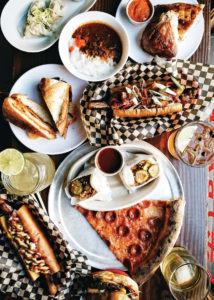
A selection of delicacies from Portland’s Pine Street Market.
March 9, 2018
SingleThread restaurant shines in Healdsburg, Spring 2018
Last fall I had the pleasure of spending 90 minutes with SingleThread chef and owner Kyle Connaughton at the outstanding Healdsburg restaurant he and his wife Katina Connaughton opened just over a year ago. Three weeks after the interview, I took my wife there for dinner for her birthday – from the dramatic tablescape of tiny ‘plates’ that welcomed us to the phenomenal wine and sake pairings, it was one of the best meals I’ve ever had.
It was a crazy time in wine country – I interviewed Kyle just three weeks after fires began sweeping through the North Bay. He and Katina were gearing up for a fundraiser and were also preparing hundreds of meals every week for those who’d been displaced from their homes.
Click here for the story:
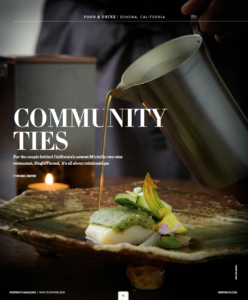
At SingleThread in Healdsburg, diners are greeted with a spread of tiny “plates” of delicacies in shells and on little wooden planks.
January 9, 2018
Oceans on the Edge, Saturday Evening Post, Jan-Feb, 2018
The opportunity to write for the oldest magazine in the USA about a topic I’m passionate about came together in the following story about the state of our oceans. Appallingly we treat as oceans mostly as sources of food, transport and recreation, and we use it as a dump, not thinking much about the animals that inhabit saline waters. Oceans are not too big to fail, as we once thought. Oceanographer Sylvia Earle, Congressman Jared Huffman and many others reveal what’s at stake in the following story. It’s not too late to save much of the remarkable diversity of our oceans, Dr. Earle says, but time is running out – we have to act now! Click the link to read the story as it appeared in the Post, or read the text below to see the unedited version, with quotes from Nancy Pelosi that were deleted in the final version.
Oceans on the edge: Still time to save the planet’s life-support system
By Michael Shapiro
Join a boat tour to the Farallon Islands, about 25 miles west of San Francisco, and you’ll likely see humpback and blue whales, gracefully arcing dolphins, sea lions, and thousands of seabirds. A bracing, salt-scented breeze scours these islands as the squawks of gulls, cormorants and common murres create an outdoor symphony. Uninhabited by humans, the 3,295-square-mile Greater Farallones National Marine Sanctuary is a poster child for healthy oceans, but beneath the surface the planet’s marine conditions are far from ideal.
* * *
On the other side of the country, 71-year-old Rip Cunningham has been fishing along the Eastern seaboard since he was 7 or 8. He recalled the remarkable abundance of striped bass and other species, a plentitude that wouldn’t last into his adult years.
“In the 1970s we went into a huge decline” for striped bass, Cunningham said. “Fishery managers put a moratorium in most every state along the Atlantic coast where there were migratory striped bass.” Some fishermen were outraged – this was considered “very drastic” action at the time.
By 2006, striped bass had reached levels that “for 50 years we hadn’t really seen,” Cunningham said. “Striped bass essentially became the crown jewel of fisheries management success.” But once a species comes back it can be hard to maintain, as fishermen want to increase their quotas, he said. “Maybe it’s just simple human nature.”
New England’s iconic fish is the Gulf of Maine codfish, he said. This is not a success story: codfish is down to 3 to 4 percent of its virgin stock. “Some say it’s environmental impact; the other end of the spectrum would say it’s all a product of long-term chronic overfishing. My opinion: it’s both,” he said. “It was a fish that was very important to a lot of communities on the New England coast, and it’s essentially gone. There are some people who believe it can be brought back, and maybe it can.”
Today it takes more than restricting fishing to bring a species back from the brink of extinction. Environmental factors such as rising ocean temperature and acidification are affecting marine species in ways we’re just beginning to understand. The Gulf of Maine is warming faster than any place along the coast of the continental United States, Cunningham said.
“We don’t know what that ultimately means to the fish out there. We know it’s impacting plankton production; we know it’s impacting the shellfish industry,” he said. “What that might ultimately do to the second most iconic species up here, the Maine lobster, the jury is out on that.”
* * *
In late August, in response to the Trump administration’s indication that it would seek to reduce the size of some national monuments, including protected ocean areas, U.S. Rep. Jared Huffman called a public hearing in Sausalito, a coastal town just north or San Francisco.
Opening the hearing, Huffman noted that protecting special marine areas has never before been a partisan issue. “President George W. Bush (a conservative Republican) designated our first four National Marine Monuments. No president has ever attempted to revoke a predecessor’s national monument designation.”
Representing a district with more than 500 miles of coastline – California’s 2nd congressional district stretches from the Golden Gate Bridge to the Oregon border – Huffman has become an expert on marine policy. “These underwater parks provide many benefits,” he said at the hearing. “They help fish populations where the fish can actually grow large enough to reproduce, not only benefiting ocean ecosystems but also global fishing communities like the ones that I represent on the North Coast.”
Several of the speakers at the hearing, including House Democratic leader Nancy Pelosi, spoke about the economic benefits of preserving the ocean, from salmon fishing to recreation. Pelosi called America’s marine sanctuaries an “irreplaceable treasure” and said, “We have a moral and practical responsibility to protect these waters and ensure that their bounty endures for responsible fishing, for research, for recreation, and for future generations. The foolishness of degrading protections for these waters could have broad and long-lasting consequences.”
Fisherman are especially concerned about proposals for opening new areas to oil drilling along the West Coast, said Noah Oppenheim, executive director of the Pacific Coast Federation of Fisherman’s Associations. Speaking at the hearing, he said oil and gas drilling inevitably causes oil spills that kill fish. He had one message for the more than 500 people who gathered at Sausalito’s Bay Institute: “Keep oil in the ground; keep it out of our ocean; keep it out of our marine sanctuaries.”
Perhaps the most heartfelt statement at the hearing came from an ordinary citizen who has long worked for ocean preservation along the Mendocino Coast, about 130 miles northwest of San Francisco. “When we were fighting to preserve our coast, our slogan was: ‘Save the Kansas Coast.’ What? Kansas?” said Rachel Binah of Little River, a seaside village near Mendocino. “Well, we felt our coast belonged to all Americans, to everyone, not just the oil companies. And we continue to feel that way today.”
The economic issues are “critical,” Binah said, “but our emotional connection to the ocean is often ignored by those who would industrialize it. We are drawn to protect it because it is beautiful and because it inspires awe. The beauty and magnificence, our universal appreciation, fills a spiritual, recreational need for personal renewal and creativity.”
* * *
The creators of the Monterey Bay Aquarium, which opened in 1984 and redefined the role of aquariums, recognized that healthy oceans can be a source of spiritual renewal. At first glance, the aquarium appears to celebrate fish (and other sea creatures) as art. As visitors enter the Open Sea exhibit, hundreds of glittering silver Pacific sardines race around a circular tank near the ceiling as ethereal music plays. Nearby are orange lion’s mane jellies (not called “jelly fish” because they’re not fish) and bioluminescent jellies that create their own colorful light.
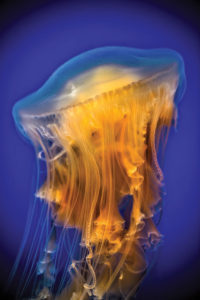
A jelly (not a jelly fish, as it’s not a fish) at the Monterey Bay Aquarium on California’s Central coast.
The aquarium aims to let visitors know how they can help preserve the ocean by changing personal habits ranging from what we eat to how much plastic we use and how we dispose of it. The goal is to explain ocean environments and see how species live in harmony, she said. “So rather than a tank with one animal in it, you walk into a room and see the kelp forest, the cathedral of the ocean, and animals that live within the kelp. The idea is to help the general public learn to love the ocean like scientists do.”
To that end a key part of the aquarium is outdoors. Its back deck is equipped with binoculars and spotting scopes trained on the wildlife in the bay. Visitors almost always spot sea otters swimming on their backs; those who are lucky may see dolphins and whales. Aquarium officials call Monterey Bay “our best exhibit.”
Program manager Ryan Bigelow said the aquarium grew out of a desire to “open up the ocean, to show that natural beauty to our guests.” Without getting political, Monterey Bay Aquarium explains some of the problems facing the ocean, such as the plastic bags swallowed by fish or seabirds, often killing them.
An early exhibition discussed overfishing, which led aquarium visitors to ask: What should I eat? This sparked the aquarium’s Seafood Watch program (seafoodwatch.org) which started as a pamphlet to help people make better seafood choices for a healthier ocean. Seafood Watch is now available on the Web and as an app. (See related story.)
Monterey Bay Aquarium works with influencers ranging from institutional food services like Aramark to chefs “who are very influential with the public,” Spring said. And the aquarium seeks to broker accords to protect species on the brink of extinction, such as the Pacific bluefin tuna, which is down to 2.6 percent of its historic numbers.” I think that Japan now is very concerned about the future of the ocean; they’re at a moment of reckoning. If they want big Pacific bluefin, they’re going to have to stop eating small Pacific bluefin.”
The bluefin fishery “is fully capable of being recovered if we could just stop” taking so many fish, Spring said. “They are fishing in the spawning areas where babies are born, you’ve got to let them get bigger. The math isn’t working here. I would just say, don’t eat Pacific bluefin tuna. Don’t do it.” In early September the aquarium announced that Pacific nations had agreed to restore populations of bluefin tuna to sustainable levels. The agreement will be monitored by an international regulatory body, the Western and Central Pacific Fisheries Commission.
Spring called it a “historic moment” for the survival of the species. “This is a significant and encouraging departure from the previous stance of this commission,” she said. “If it is implemented appropriately, it will recover the population” of bluefin tuna to 20 percent of historic populations by 2034.
* * *
Fish is the last widely available wild protein – we don’t eat wild chickens or pigs or beef for the most part – and it’s efforts like the bluefin tuna accord that could sustain fisheries for many generations.
Asked if we’re in the era of the last wild fish for human consumption, Spring cited cause for hope: “That’s up to us. We’ve driven the ocean to the brink, but we can bring it back.” Sunfish take a long time to grow and mature “so if everyone is eating those, yes they will disappear,” she said. “But there are other fish like mahi mahi which reproduce quite quickly, and they’re delicious.”
Farmed fish and shellfish are inevitably going to be part of the equation – and that’s not necessarily a bad thing, said Ryan Bigelow, program engagement manager for Seafood Watch. At least 50 percent of the fish Americans eat is farmed, he said. “While some of that is very, very red (not recommended), some of it is very well done. But the public overall has a very negative image of what farmed seafood is. So if there’s a good farmed seafood story, we’ll tell it.”
The idea that “we’re going to feed ourselves solely with wild seafood, that’s never going to happen,” Bigelow added. “We have to have farmed products, and if that’s the case then we have to do it well. If you needed a panacea, we could just farm mussels and clams. You could provide all the protein for the world in a very small area with clams. Now is the entire world going to get on board with just eating clams, I doubt it very highly.”
Mussels and clams can be cultivated in large numbers relatively easily, but because most people generally want to eat them occasionally if at all, he said, they’re just a small part of our diet. “They don’t need feed, (and) everything that we think about farmed fish, overcrowding, they love.” Bigelow said. “You could feed the entire world very effectively and sustainably with aquaculture.”
* * *
Limiting the catch of wild fish raises the question: What about the people around the world who depend on fish for sustenance? “Most of the fish that have been taken out of the ocean have not gone to poor populations,” said David Helvarg, executive director of Blue Frontier, an ocean advocacy group. “High-tech fishing fleets have stripped coastal waters from poor countries in order to provide a constant supply to the supermarket and white-linen-tablecloth restaurants in Europe, North America and Japan, and increasingly China.”
But sometimes the little guys fight back – and win. “A few years ago Senegal took away fishing permits from foreign trawlers and within six months, local fishermen were catching levels of fish they hadn’t seen in a generation,” Helvarg said. And after Indonesia’s navy helped banish almost 400 pirate vessels, hundreds of thousands of local Indonesian fishermen are seeing a recovery of their livelihood.”
Yet the overall recovery of oceans depends on forces beyond the seas. Helvarg said he’s “more frustrated than despairing with the ongoing disasters on our blue planet because we know what the solutions are. If you stop killing fish they tend to grow back. If you stop producing 100 million metric tons of throw-away plastic every year, then you don’t face huge plastic pollution of our oceans. If we don’t turn around the trend lines by mid-century, there could be more weight of plastic in the ocean than of living fish.”
Another issue is that ocean acidification threatens shellfish, said Helvarg, author of The Golden Shore: California’s Love Affair with the Sea. “I love oysters, raw oysters; they are mostly grown (farmed) now. But those who are growing oysters are facing problems due to acidification. As the ocean becomes more acidic, it eats away the shells.”
With the evidence piling up about ocean stability reaching a tipping point, we haven’t taken more decisive action because “the problem with environmental stories is they don’t break, they ooze,” Helvarg said. In other words, the full impact of carbon emissions on oceans, for example, won’t be felt for many years. “The trend lines are still challenging, but at least we recognize what the solutions are, and now we have to start working seriously to build the resilience for our coasts and oceans.”
Putting the seriousness of the issue in perspective, Sylvia Earle, the former chief scientist at NOAA, said, “It’s not just a matter of no longer getting to dine on blue-fin tuna – if humans push the ocean past the point of no return, we could go down with the ship. Our life-support system is at risk.”
Even from a purely economic perspective, healthy oceans make sense, she said. “This is not about jobs. Jobs come where there’s prosperity. When we destroy the natural systems, poverty, wars, lack of prosperity follow. We need clean water, we need places to live, we need a quality of life that causes people to feel good, to be happy, to feel secure.”
When humans act responsibly, Helvarg said, oceans tend to rebound. “After chasing the whales down, (seafarers) started killing elephant seals for their oil, and by 1896 there were an estimated 20 to 100 elephant seals left” along the Pacific coast, said Helvarg.
“In the 1960s and ’70s we changed our attitudes and created the Marine Mammal Protection Act, the Clean Water Act, and we protected offshore breeding islands in the Channel Islands. In 1990, the first elephant seal hauled up on the beach near San Clemente, (Calif.), the first breeding pair was there in 1992, and last year 27,000 returned just to that one beach,” he said.
“When we do the right things, life comes back.”
-end-
Sidebar
Seafood Watch guide can help you choose wisely
We can all limit our impact on the ocean and restore the seas to health. Author David Helvarg’s book 50 Ways to Save the Oceans suggests reducing plastic use, picking up trash on beaches, lobbying for ocean preservation, and supporting groups working to protect oceans, such as Sylvia Earle’s Mission Blue, mission-blue.org.
But perhaps the most important thing each of us can do is to make sensible choices when consuming fish and seafood. For advice on consuming seafood and fish to avoid, see Monterey Bay Aquarium’s Seafood Watch guide at seafoodwatch.org or download the free Seafood Watch app. Print guides are also distributed at the aquarium.
Seafood Watch sorts fish choices into three categories: Best Choices (coded green), Good Alternatives (yellow), and Avoid (red). Best choices are “well managed and caught or farmed in ways that cause little harm to habitats or other wildlife,” says the Seafood Watch site.
Among the best choices are albacore tuna caught with hand-operated poles or trolling lines and handline-caught yellowfin tuna. However other types of tuna are on the Avoid list, most notably bluefin tuna that is now below 3 percent of historic population levels. There are now about 1,300 recommendations on the Seafood Watch site, and it can be daunting to try to discern an acceptable type of tuna from one on the brink of extinction.
“The best advice is to look for businesses with a sustainable seafood commitment,” said Seafood Watch program engagement manager Ryan Bigelow. “It’s a whole new level of complexity, and frankly we’re all too busy to really think about it in our day-to-day lives, so look for a Seafood Watch partner.” These partners display the Seafood Watch logo and should only serve fish endorsed by the program.
Seafood Watch also has a sushi guide that warns against consuming threatened species such as eel (unagi) and recommends alternatives such Arctic char, sardines and sablefish.
At least 50 percent of what we eat his farmed, Bigelow said. “While some of that is very, very red (should be avoided because it’s damaging to the environment), some of it is very well done. But the public overall has a very negative image of what farmed seafood is. So if there is a good farmed seafood story, we will tell it.”
-Michael Shapiro
Since watching Jacques Cousteau TV specials as a boy in the 1970s, Michael Shapiro has been entranced by ocean life. But it wasn’t until he saw the 2014 Nexflix documentary, Mission Blue, about the work of undersea explorer Sylvia Earle, that he realized how serious the threats to our seas have become — and that we’re all dependent on healthy oceans for our survival. Recently he’s swum with penguins and rays in the Galapagos, kayaked under San Francisco’s Golden Gate Bridge, and paddleboarded among humpback whales and bald eagles on Alaska’s Glacier Bay.
August 8, 2017
Tuscany tastes better, a food tour with Frances Mayes, Inspirato, Summer 2017
I first interviewed Frances Mayes at her home in Tuscany in 2003 for my book of interviews with travel writers, A Sense of Place. It was a pleasure to speak with Mayes again in autumn 2016 for a story about the cuisine of this region of Italy, where food appreciation rivals devotion to the saints.
To read the story click this PDF: INSP-Frances Mayes.sm
Or find it on Inspirato’s site by clicking here and going to page 86 of this online magazine reader.
Here’s an excerpt:
It’s summer in Tuscany and Frances Mayes, author of Under the Tuscan Sun, is shopping at a fruit stand in her adopted home of Cortona. “Are these peaches local?” she asks the elderly woman at her cart as the sweet scent of the fruit perfumes the air. “Oh no, signora,” the vendor apologizes. “They’re from Castiglion Fiorentino.” Which is just five miles away.
That exchange reveals Tuscans’ preference for hyper-local food, one of the essential ingredients that makes it so heavenly. Italians in general and Tuscans in particular revere simple dishes made from ingredients found near (or at) their homes, but their appreciation for food goes deeper than taste.
In Tuscany, food isn’t just something to eat – it’s something to do with family and friends: harvesting wild mushrooms, picking olives, canning tomatoes, sharing big bowls of pasta, and gathering for dinners where everyone helps cook and conversations flow deep into the night. “There is an intense passion for local food, and it’s particularly focused on what you can find yourself,” Mayes told me last fall. (2016) “And that’s what I see that is so different from living” in the United States.
“In Tuscany right this minute (early October) everybody is out looking for the mazza di tamburo, the mushroom of the moment. That means drumstick – it’s shaped like a drumstick with a long stem and a big flathead. You find them on your own land and saute them with garlic,” Mayes said. Italians “don’t even want them on pasta – they just want them on little crostini because they so want to taste this wild mushroom. And in the spring it’s strange things like the green almonds. Everybody loves those crunchy green almonds before they really turn into a nut. To me that’s very much an acquired taste, but local people really like them.”
Turning junk into the art of the possible, Sierra magazine, August 2017
It’s been about 16 years since Patrick Amiot began transforming his street, and eventually much of Sebastopol, into an outdoor art gallery. About a decade ago we became neighbors and we’d hang out on his porch talking about life, art and turning dreams into reality. I wrote a short piece about Sebastopol for Sunset and mentioned his work, I also wrote about him and his wife Brigitte Laurent for Sonoma magazine and The Press Democrat.
From 2013 to 2016, Eric McIntyre and I made a short film about Amiot and Laurent’s work, click here to watch the trailer. But he spoke as eloquently as ever in a recent interview with me for this story in Sierra magazine.
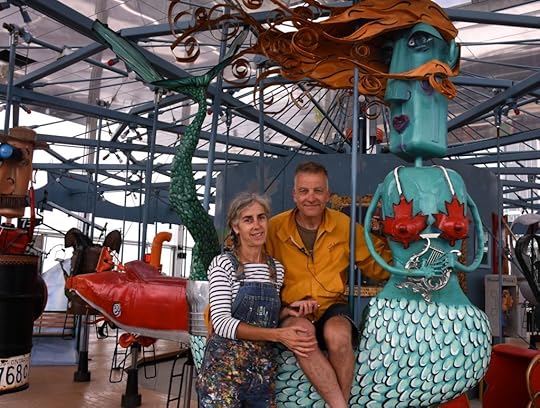
Brigitte Laurent and Patrick Amiot in front of their masterpiece, a carousel with 44 of his ride-able figures installed near Toronto in 2016.
Excerpt from Sierra magazine: Amiot and Laurent hope their message is about more than turning junk into art and reducing the amount of waste going into landfills. They hope their work demonstrates how a neighborhood can be a “magical place” where kids grow up thinking anything is possible.
“All of a sudden, it’s normal to have something big, bold, and crazy in front of your house. That to me is way more important than anything else,” Amiot said. “In mainstream America, you don’t see giant sculptures in front of people’s houses, but if you’re brought up in this community, it’s a natural thing. These people grow up thinking it’s alright to show your colors and do wild and crazy things. And it just so happens that the things they saw were actually made out of recycled materials.”
Michael Shapiro's Blog
- Michael Shapiro's profile
- 3 followers


